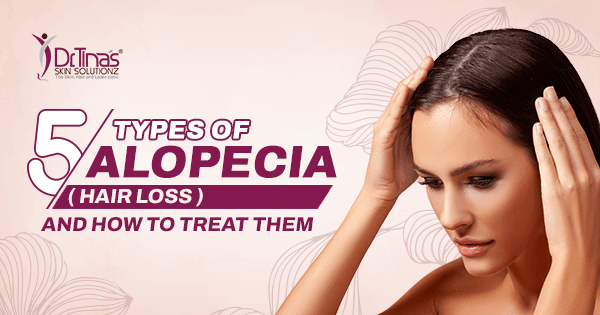5 Types of Alopecia (Hair Loss) and How to Treat Them
Five Types of Alopecia (Hair Loss) and Their Treatments

Recently, Nitin has noticed his hairline starting to recede. At just over twenty years old, this has taken a toll on his confidence, affecting both his personal life and work performance. Unfortunately, this is a common issue for more than 80% of men and over half of women who experience some form of hair loss or alopecia. Fortunately, advancements in modern hair loss treatments in Bangalore have made finding the right solution much easier.
Understanding Alopecia
Alopecia is an umbrella term used to describe conditions characterized by sudden or gradual hair loss. While alopecia itself doesn’t necessarily indicate other health problems, it can sometimes signal internal changes within the body. There are several ways alopecia can manifest, each with its own unique characteristics.
It's important to differentiate between normal hair shedding and alopecia. It's natural for humans to lose between 50 to 100 strands daily. Therefore, don't confuse regular hair loss with alopecia.
Types of Alopecia
The manifestation of alopecia varies from person to person, depending on the pattern, cause, and gender.
Androgenic Alopecia
Both men and women commonly experience androgenic alopecia, which typically involves a gradual thinning of hair on the scalp. This condition is often due to genetic factors and, in some cases, environmental influences. In men, this type of hair loss is referred to as male-pattern baldness and usually presents as an M-shaped receding hairline at the front and top of the scalp. Over time, this can lead to partial or total baldness. Women with androgenic alopecia often notice widening of their partings, with a decrease in overall hair density on the crown. Interestingly, many women retain their frontal hairlines.
Alopecia Areata
Alopecia areata is characterized by the loss of hair in round or oval patches on the scalp or elsewhere on the body. This condition is generally autoimmune, where the immune system mistakenly attacks the hair follicles. Many individuals also experienced hair loss following the COVID-19 pandemic, known as telogen effluvium. Alopecia areata can be emotionally challenging for those affected. Often, doctors will recommend waiting for the hair to grow back naturally before considering treatment. Some patients may initially respond to treatment, but the condition frequently recurs, making a permanent cure elusive.
Alopecia Universalis
This condition involves the complete loss of hair from the scalp and body. Individuals with alopecia universalis may lose hair from areas such as the eyebrows, eyelashes, arms, legs, and pubic regions. Alopecia universalis is considered a more severe form of alopecia areata and tends to run in families.
Traction Alopecia
Traction alopecia occurs when hair is consistently pulled or stretched due to tight hairstyles like ponytails, braids, or hair extensions. This constant strain damages the hair follicles, potentially leading to irreversible hair loss if not addressed early. Symptoms of this condition include scalp redness, bumps, itching, and folliculitis.
Cicatricial Alopecia
One of the more severe forms of alopecia, cicatricial alopecia is marked by inflammation of the hair follicles, resulting in scarring. This scarring is caused by scar tissue formation, ultimately leading to permanent hair loss. Symptoms include scalp itchiness, heat, and pustules, and diagnosis often requires a scalp biopsy.
Treatment Options for Alopecia
Hair loss treatments in Bangalore offer various solutions for individuals dealing with different forms of alopecia.
Platelet-Rich Plasma (PRP) Therapy
PRP therapy is among the most popular treatments for hair loss. This process involves drawing, processing, and injecting the patient's blood plasma into the scalp. PRP has proven beneficial for regrowing hair by promoting healing of scalp tissues and hair follicles. The proteins in PRP stimulate regeneration, yielding positive results.
Growth Factor Concentrate (GFC) Treatment
GFC treatment is another effective method for combating hair loss. This treatment uses highly concentrated plasma, which, when injected into the scalp and neck, promotes hair growth.
Corticosteroid Injections
Certain types of alopecia can be managed with corticosteroid injections. These injections are particularly effective for treating hair loss caused by the immune system attacking hair follicles, such as alopecia areata and alopecia universalis. Treatment usually requires multiple sessions every four to eight weeks, as recommended by the doctor.
Medical Management
In addition to these treatments, medical professionals often suggest addressing nutritional and lifestyle factors contributing to hair loss. Consistent use of prescribed medications can help restore hair growth.
Since the causes of alopecia can vary, responses to treatments differ. While some types may not require intervention, others may necessitate professional treatment. However, consulting an expert before beginning any treatment is essential.

Dr. Tina Ramachander is one of the best dermatologists in Bangalore and the Medical Director at Dr. Tina’s Skin Solutionz, a skin care clinic in Bangalore. She holds a master’s degree in dermatology from the prestigious JJM Medical College in Karnataka and currently practices as a dermatosurgeon and Medical Cosmetologist in Bangalore.